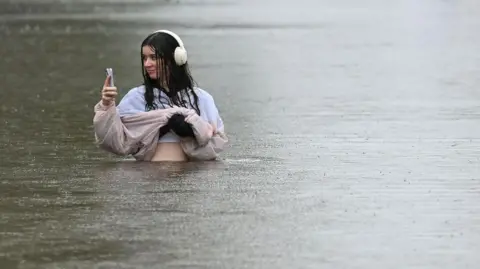The reliability of weather forecasts is a topic of growing concern as technology and social media reshape how we receive information. In recent years, many individuals have turned to data-driven meteorology from unconventional sources and platforms, often foregoing traditional channels for personal, relatable updates in the face of severe weather events. The prevalence of amateur weather forecasters, such as Andrew Brown with his popular Facebook page, “Wally’s Weather,” raises questions about whom the public can truly trust for accurate updates.
Based in Townsville, Queensland, Brown showcases his dedication as he invests considerable time and effort into providing real-time weather updates. With 107,000 followers and a staggering 24 million monthly views, Brown’s influence skyrocketed during the record-breaking floods that inundated the region, displacing hundreds. As a cybersecurity lecturer by profession, Brown’s passion for meteorology emerged from a desire to inform and protect his local community during dangerous weather events. His proactive approach, including publishing updates at all hours and even sharing vital information with colleagues and family, has granted him a sense of purpose in his role as a weather influencer.
Research trends are illuminating how individuals increasingly rely on social media influencers for news, including weather-related updates. According to findings from the Pew Research Centre, 20% of adults in the U.S. utilize social platforms for forecasts and advisories. Influencers like Brown gain as much clout, if not more, than mainstream journalists, being particularly appealing to those in remote areas where traditional media may fall short. The interactivity that social media provides allows weather influencers to directly engage with audiences who seek immediate, localized information, creating an unprecedented connection between forecasters and their followers.
However, this shift does not come without its challenges. Professor Daniel Angus from the Queensland University of Technology acknowledges that while many people are turning to weather influencers for localized updates, there remains a significant portion of the public that adheres to official forecasts from trusted sources like the Australian Bureau of Meteorology. Angus recognizes that the influence of weather personalities arises from a growing cynicism towards mainstream media, emphasizing their relatability and ability to cover gaps that traditional outlets often miss. This grassroots engagement often fosters a sense of community and trust that is indispensable during a crisis.
On the flip side, the amateur status of many popular weather influencers raises concerns regarding accuracy and accountability. Reports have surfaced criticizing certain weather influencers, like Higgins Storm Chasing, for spreading alarmist forecasts that fail to predict actual weather events accurately. The distinction between trained meteorologists and less qualified individuals is crucial; the former operate under professional standards, while the latter may prioritize engagement over factual reliability. The consequences of this lack of oversight can undermine public trust and create confusion regarding severe weather advisories.
Alan Sealls, a former television meteorologist and current educator at the University of South Alabama, emphasizes the inherent risks that come with this dynamic. His evaluation of long-range forecasts showcases a clear divergence between scientifically grounded predictions and sensationalist claims that appeal to audiences through fear-based messaging. According to Sealls, as influencers thrive in the “attention economy” by boosting engagement metrics, their approach may compromise communication accuracy, leading to misinformation that could have dire consequences during extreme weather events.
Nonetheless, it is important to recognize the instances where weather influencers provide essential community-based forecasting that fills vital information gaps. Individuals like Brown possess a unique capability to engage with their local areas more thoroughly than larger media infrastructures. Their first-hand experiences in affected regions offer perspectives that traditional outlets may overlook. As they continue to evolve in their respective roles, these influencers can not only bridge the gap in information but also foster a deeper connection within their communities.
The conversation surrounding who to trust for weather forecasts emphasizes not only the changing nature of information consumption but the need for a delicate balance. While traditional meteorological organizations provide important accuracy and reliability, individuals like Andrew Brown demonstrate how effective and relatable personalized communication can enhance community safety measures during significant weather events. As the landscape continues to shift, understanding the value of both professional meteorological guidance and informative local influencers will be essential.



